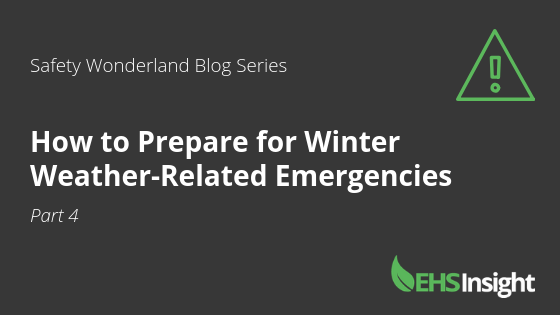Winter weather is one of the biggest threats to workers, whether you’re driving to or from work or simply doing business as usual. While snow and ice can make for hazardous road conditions, freezing temperatures can put you at risk for serious conditions like hypothermia, frostbite, or overexertion.
These safety tips can help you prepare for the upcoming winter season while also giving you peace of mind that you can face whatever winter disasters come your way.
Home Preparation
The biggest threat to homes during a winter storm is losing power. This can set off a domino effect of losing heat, being unable to cook, freezing pipes, and being unable to call for help in the event of an emergency.
Most power outages do not last more than a couple of days, but the snow and ice may prevent you from venturing any further than your driveway for days. In any case, you’ll want to prepare with the following safety tips:
- Stock up on emergency essentials: flashlights, batteries, water, non-perishable food, first aid supplies, baby items (diapers, formula, etc), emergency heat sources (firewood, DIY heaters, etc), pet food, and other necessaries.
- Make sure smoke and carbon monoxide detectors are in good working order, as house fires are common during power outages.
- Keep children and pets away from heat sources that could cause burns or potentially start a fire.
- Bring pets inside in the event of extreme weather.
- Keep your cell phone charged and only use it in the event of an emergency.
Workplace Preparation
Many of the same weather-related threats at home can also be found in the workplace, but workers may be subjected to additional conditions.
Keep the following workplace safety tips in mind, especially if your work is performed outside.
- Dress for the occasion: check out our blog post on layering guidelines and safe winter workwear.
- Know the signs of hypothermia, frostbite, and other serious conditions. Numbness, change in skin color, dizziness, shivering, exhaustion, confusion, or a drop in body temperature shouldn’t go ignored. Get out of the cold and warm yourself from your core to your extremities.
- If the power is out at work, check to see if your attendance is truly necessary. Don’t risk it unless it’s absolutely critical.
Vehicle Preparation
Ideally, you won’t have to drive anywhere when it’s snowing or icy. But sometimes, business must continue. Keep the following road hazards and safety tips in mind when operating a vehicle in winter weather conditions.
- Always keep emergency supplies in your personal and company vehicles, including cell phone chargers, blankets, gloves, first aid kit, jumper cables, tow rope, water, flashlight and extra batteries, maps, and food.
- Do a vehicle inspection prior to severe winter weather to ensure tires, brakes, windshield wipers, and lights are all in good working order.
- Keep your gas tank full.
- If you must drive in snowy or icy conditions, check your route ahead of time and try to stick to main roads.
- Keep emergency contact numbers in your vehicle, including the number of a tow truck company.
- Beware black ice may still linger, even if most of the snow and ice are gone.
- Wet roads will refreeze when temperatures drop, so drive with caution.
- Keep alert for potential floods as snow and ice begin to melt.
For Your Health and Wellness
Once the winter weather abates, the dangers aren’t necessarily gone. Consider the following best safety practices when venturing out after a storm.
- Stay away from downed power lines and debris in the road.
- Use sand or salt to provide traction on walkways and driveways.
- Stay indoors as much as possible to avoid illness or serious conditions like frostbite or hypothermia.
- Restock your emergency kit as your earliest convenience to prepare for future winter weather disasters.
There’s nothing you can do to stop winter weather conditions, but you can take control of how you prepare yourself. A little forethought can go a long way in keeping you protected from dangerous weather this winter.
Check out our other posts in the Safety Wonderland blog series:
